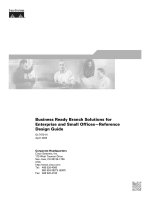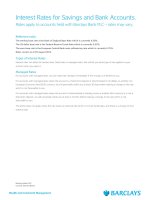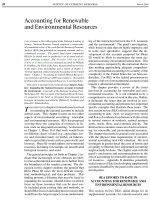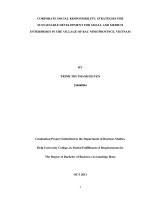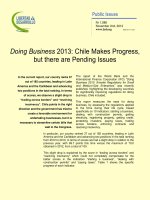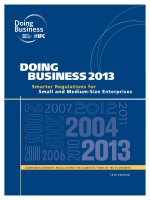DOING BUSINESS 2013: SMARTER REGULATIONS FOR SMALL AND MEDIUM-SIZE ENTERPRISES doc
Bạn đang xem bản rút gọn của tài liệu. Xem và tải ngay bản đầy đủ của tài liệu tại đây (1.68 MB, 118 trang )
Economy
Economy Profile:
St. Brazil
2
Brazil
Doing Business 2013
© 2013 The International Bank for Reconstruction and Development /
The World Bank
1818 H Street NW, Washington, DC 20433
Telephone: 202-473-1000; Internet: www.worldbank.org
All rights reserved.
1 2 3 4 15 14 13 12
A copublication of The World Bank and the International Finance Corporation.
This work is a product of the staff of The World Bank with external contributions.
Note that The World Bank does not necessarily own each component of the content
included in the work. The World Bank therefore does not warrant that the use of the
content contained in the work will not infringe on the rights of third parties. The risk
of claims resulting from such infringement rests solely with you.
The findings, interpretations, and conclusions expressed in this work do not
necessarily reflect the views of The World Bank, its Board of Executive Directors, or
the governments they represent. The World Bank does not guarantee the accuracy of
the data included in this work. The boundaries, colors, denominations, and other
information shown on any map in this work do not imply any judgment on the part of
The World Bank concerning the legal status of any territory or the endorsement or
acceptance of such boundaries.
Nothing herein shall constitute or be considered to be a limitation upon or waiver of
the privileges and immunities of The World Bank, all of which are specifically
reserved.
Rights and Permissions
This work is available under the Creative Commons Attribution 3.0 Unported license
(CC BY 3.0) Under the Creative
Commons Attribution license, you are free to copy, distribute, transmit, and adapt
this work, including for commercial purposes, under the following conditions:
Attribution—Please cite the work as follows: World Bank. 2013. Doing Business 2013:
Smarter Regulations for Small and Medium-Size Enterprises. Washington, DC: World
Bank Group. DOI: 10.1596/978-0-8213-9615-5. License: Creative Commons
Attribution CC BY 3.0
Translations—If you create a translation of this work, please add the following
disclaimer along with the attribution: This translation was not created by The World
Bank and should not be considered an official World Bank translation. The World Bank
shall not be liable for any content or error in this translation.
All queries on rights and licenses should be addressed to the Office of the Publisher,
The World Bank, 1818 H Street NW, Washington, DC 20433, USA; fax: 202-522-2625;
e-mail:
Additional copies of all 10 editions of Doing Business may be purchased at
www.doingbusiness.org.
Cover design: Corporate Visions, Inc.
3
Brazil
Doing Business 2013
CONTENTS
Introduction 4
The business environment 5
Starting a business 14
Dealing with construction permits 26
Getting electricity 36
Registering property 43
Getting credit 55
Protecting investors 62
Paying taxes 71
Trading across borders 79
Enforcing contracts 88
Resolving insolvency 99
Employing workers 105
Data notes 112
Resources on the Doing Business website 117
4
Brazil
Doing Business 2013
INTRODUCTION
Doing Business sheds light on how easy or difficult it is
for a local entrepreneur to open and run a small to
medium-size business when complying with relevant
regulations. It measures and tracks changes in
regulations affecting 11 areas in the life cycle of a
business: starting a business, dealing with construction
permits, getting electricity, registering property,
getting credit, protecting investors, paying taxes,
trading across borders, enforcing contracts, resolving
insolvency and employing workers.
In a series of annual reports Doing Business presents
quantitative indicators on business regulations and the
protection of property rights that can be compared
across 185 economies, from Afghanistan to Zimbabwe,
over time. The data set covers 46 economies in Sub-
Saharan Africa, 33 in Latin America and the Caribbean,
24 in East Asia and the Pacific, 24 in Eastern Europe
and Central Asia, 19 in the Middle East and North
Africa and 8 in South Asia, as well as 31 OECD high-
income economies. The indicators are used to analyze
economic outcomes and identify what reforms have
worked, where and why.
This economy profile presents the Doing Business
indicators for Brazil. To allow useful comparison, it also
provides data for other selected economies
(comparator economies) for each indicator. The data in
this report are current as of June 1, 2012 (except for
the paying taxes indicators, which cover the period
January–December 2011).
The Doing Business methodology has limitations. Other
areas important to business—such as an economy‘s
proximity to large markets, the quality of its
infrastructure services (other than those related to
trading across borders and getting electricity), the
security of property from theft and looting, the
transparency of government procurement,
macroeconomic conditions or the underlying strength
of institutions—are not directly studied by Doing
Business. The indicators refer to a specific type of
business, generally a local limited liability company
operating in the largest business city. Because
standard assumptions are used in the data collection,
comparisons and benchmarks are valid across
economies. The data not only highlight the extent of
obstacles to doing business; they also help identify the
source of those obstacles, supporting policy makers in
designing regulatory reform.
More information is available in the full report. Doing
Business 2013 presents the indicators, analyzes their
relationship with economic outcomes and presents
business regulatory reforms. The data, along with
information on ordering Doing Business 2013, are
available on the Doing Business website at
.
5
Brazil
Doing Business 2013
THE BUSINESS ENVIRONMENT
For policy makers trying to improve their economy‘s
regulatory environment for business, a good place to
start is to find out how it compares with the regulatory
environment in other economies. Doing Business
provides an aggregate ranking on the ease of doing
business based on indicator sets that measure and
benchmark regulations applying to domestic small to
medium-size businesses through their life cycle.
Economies are ranked from 1 to 185 by the ease of
doing business index. For each economy the index is
calculated as the ranking on the simple average of its
percentile rankings on each of the 10 topics included in
the index in Doing Business 2013: starting a business,
dealing with construction permits, getting electricity,
registering property, getting credit, protecting
investors, paying taxes, trading across borders,
enforcing contracts and resolving insolvency. The
ranking on each topic is the simple average of the
percentile rankings on its component indicators (see
the data notes for more details). The employing workers
indicators are not included in this year‘s aggregate ease
of doing business ranking, but the data are presented
in this year‘s economy profile.
The aggregate ranking on the ease of doing business
benchmarks each economy‘s performance on the
indicators against that of all other economies in the
Doing Business sample (figure 1.1). While this ranking
tells much about the business environment in an
economy, it does not tell the whole story. The ranking on
the ease of doing business, and the underlying
indicators, do not measure all aspects of the business
environment that matter to firms and investors or that
affect the competitiveness of the economy. Still, a high
ranking does mean that the government has created a
regulatory environment conducive to operating a
business.
ECONOMY OVERVIEW
Region: Latin America & Caribbean
Income category: Upper middle income
Population: 196,655,014
GNI per capita (US$): 10,720
DB2013 rank: 130
DB2012 rank: 128*
Change in rank: -2
* DB2012 ranking shown is not last year‘s published
ranking but a comparable ranking for DB2012 that
captures the effects of such factors as data
corrections and the addition of 2 economies
(Barbados and Malta) to the sample this year. See
the data notes for sources and definitions.
6
Brazil
Doing Business 2013
THE BUSINESS ENVIRONMENT
Figure 1.1 Where economies stand in the global ranking on the ease of doing business
Source: Doing Business database.
7
Brazil
Doing Business 2013
THE BUSINESS ENVIRONMENT
For policy makers, knowing where their economy
stands in the aggregate ranking on the ease of
doing business is useful. Also useful is to know how
it ranks relative to comparator economies and
relative to the regional average (figure 1.2). The
economy‘s rankings on the topics included in the
ease of doing business index provide another
perspective (figure 1.3).
Figure 1.2 How Brazil and comparator economies rank on the ease of doing business
Source: Doing Business database.
8
Brazil
Doing Business 2013
THE BUSINESS ENVIRONMENT
Figure 1.3 How Brazil ranks on Doing Business topics
Source: Doing Business database.
9
Brazil
Doing Business 2013
THE BUSINESS ENVIRONMENT
Just as the overall ranking on the ease of doing business
tells only part of the story, so do changes in that ranking.
Yearly movements in rankings can provide some indication
of changes in an economy‘s regulatory environment for
firms, but they are always relative. An economy‘s ranking
might change because of developments in other
economies. An economy that implemented business
regulation reforms may fail to rise in the rankings (or may
even drop) if it is passed by others whose business
regulation reforms had a more significant impact as
measured by Doing Business.
Moreover, year-to-year changes in the overall rankings do
not reflect how the business regulatory environment in an
economy has changed over time—or how it has changed
in different areas. To aid in assessing such changes, last
year Doing Business introduced the distance to frontier
measure. This measure shows how far each economy is
from the best performance achieved by any economy since
2005 on each indicator in 9 Doing Business indicator sets.
Comparing the measure for an economy at 2 points in
time allows users to assess how much the economy‘s
regulatory environment as measured by Doing Business
has changed over time—how far it has moved toward (or
away from) the most efficient practices and strongest
regulations in areas covered by Doing Business (figure 1.4).
The results may show that the pace of change varies widely
across the areas measured. They also may show that an
economy is relatively close to the frontier in some areas
and relatively far from it in others.
Figure 1.4 How far has Brazil come in the areas measured by Doing Business?
Note: The distance to frontier measure shows how far on average an economy is from the best performance achieved by any
economy on each Doing Business indicator since 2005. The measure is normalized to range between 0 and 100, with 100 representing
the best performance (the frontier). The overall distance to frontier is the average of the distance to frontier in the 9 indicator sets
shown in the figure. See the data notes for more details on the distance to frontier measure.
Source: Doing Business database.
10
Brazil
Doing Business 2013
THE BUSINESS ENVIRONMENT
The absolute values of the indicators tell another part
of the story (table 1.1). The indicators, on their own or
in comparison with the indicators of a good practice
economy or those of comparator economies in the
region, may reveal bottlenecks reflected in large
numbers of procedures, long delays or high costs. Or
they may reveal unexpected strengths in an area of
business regulation—such as a regulatory process that
can be completed with a small number of procedures
in a few days and at a low cost. Comparison of the
economy‘s indicators today with those in the previous
year may show where substantial bottlenecks persist—
and where they are diminishing.
Table 1.1 Summary of Doing Business indicators for Brazil
Indicator
Brazil DB2013
Brazil DB2012
Chile DB2013
China DB2013
Colombia DB2013
India DB2013
Japan DB2013
Mexico DB2013
Best performer globally
DB2013
Starting a Business
(rank)
121
122
32
151
61
173
114
36
New Zealand (1)
Procedures (number)
13
13
7
13
8
12
8
6
New Zealand (1)*
Time (days)
119
119
8
33
13
27
23
9
New Zealand (1)
Cost (% of income per
capita)
4.8
5.4
4.5
2.1
7.3
49.8
7.5
10.1
Slovenia (0.0)
Paid-in Min. Capital (%
of income per capita)
0.0
0.0
0.0
85.7
0.0
140.1
0.0
0.0
91 Economies (0.0)*
Dealing with
Construction Permits
(rank)
131
130
84
181
27
182
72
36
Hong Kong SAR,
China (1)
Procedures (number)
17
17
15
28
8
34
14
10
Hong Kong SAR,
China (6)*
Time (days)
469
469
155
270
46
196
193
69
Singapore (26)
Cost (% of income per
capita)
36.0
40.2
67.3
375.3
312.0
1,528.0
28.5
322.7
Qatar (1.1)
11
Brazil
Doing Business 2013
Indicator
Brazil DB2013
Brazil DB2012
Chile DB2013
China DB2013
Colombia DB2013
India DB2013
Japan DB2013
Mexico DB2013
Best performer globally
DB2013
Getting Electricity
(rank)
60
61
40
114
134
105
27
130
Iceland (1)
Procedures (number)
6
6
6
5
5
7
3
7
Germany (3)*
Time (days)
57
57
31
145
165
67
105
95
Germany (17)
Cost (% of income per
capita)
116.7
130.3
67.6
547.0
995.0
247.3
0.0
382.8
Japan (0.0)
Registering Property
(rank)
109
105
55
44
52
94
64
141
Georgia (1)
Procedures (number)
14
13
6
4
7
5
6
7
Georgia (1)*
Time (days)
34
33
31
29
15
44
14
74
Portugal (1)
Cost (% of property
value)
2.6
2.6
1.3
3.6
2.0
7.3
5.8
5.3
Belarus (0.0)*
Getting Credit (rank)
104
97
53
70
70
23
23
40
United Kingdom (1)*
Strength of legal rights
index (0-10)
3
3
6
6
5
8
7
6
Malaysia (10)*
Depth of credit
information index (0-6)
5
5
5
4
5
5
6
6
United Kingdom (6)*
Public registry coverage
(% of adults)
46.8
36.1
37.4
27.7
0.0
0.0
0.0
0.0
Portugal (90.7)
Private bureau
coverage (% of adults)
62.2
61.5
3.5
0.0
72.5
14.9
100.0
99.2
United Kingdom
(100.0)*
Protecting Investors
(rank)
82
79
32
100
6
49
19
49
New Zealand (1)
Extent of disclosure
6
6
8
10
8
7
7
8
Hong Kong SAR,
12
Brazil
Doing Business 2013
Indicator
Brazil DB2013
Brazil DB2012
Chile DB2013
China DB2013
Colombia DB2013
India DB2013
Japan DB2013
Mexico DB2013
Best performer globally
DB2013
index (0-10)
China (10)*
Extent of director
liability index (0-10)
7
7
6
1
8
4
6
5
Singapore (9)*
Ease of shareholder
suits index (0-10)
3
3
5
4
9
7
8
5
New Zealand (10)*
Strength of investor
protection index (0-10)
5.3
5.3
6.3
5.0
8.3
6.0
7.0
6.0
New Zealand (9.7)
Paying Taxes (rank)
156
154
36
122
99
152
127
107
United Arab Emirates
(1)
Payments (number per
year)
9
9
6
7
9
33
14
6
Hong Kong SAR,
China (3)*
Time (hours per year)
2,600
2,600
291
338
203
243
330
337
United Arab Emirates
(12)
Trading Across Borders
(rank)
123
123
48
68
91
127
19
61
Singapore (1)
Documents to export
(number)
7
7
6
8
5
9
3
5
France (2)
Time to export (days)
13
13
15
21
14
16
10
12
Singapore (5)*
Cost to export (US$ per
container)
2,215
2,215
980
580
2,255
1,120
880
1,450
Malaysia (435)
Documents to import
(number)
8
8
6
5
6
11
5
4
France (2)
Time to import (days)
17
17
12
24
13
20
11
12
Singapore (4)
Cost to import (US$ per
container)
2,275
2,275
965
615
2,830
1,200
970
1,780
Malaysia (420)
13
Brazil
Doing Business 2013
Indicator
Brazil DB2013
Brazil DB2012
Chile DB2013
China DB2013
Colombia DB2013
India DB2013
Japan DB2013
Mexico DB2013
Best performer globally
DB2013
Enforcing Contracts
(rank)
116
120
70
19
154
184
35
76
Luxembourg (1)
Time (days)
731
731
480
406
1,346
1,420
360
415
Singapore (150)
Cost (% of claim)
16.5
16.5
28.6
11.1
47.9
39.6
32.2
31.0
Bhutan (0.1)
Procedures (number)
44
45
36
37
34
46
30
38
Ireland (21)*
Resolving Insolvency
(rank)
143
139
98
82
21
116
1
26
Japan (1)
Time (years)
4.0
4.0
3.2
1.7
1.3
4.3
0.6
1.8
Ireland (0.4)
Cost (% of estate)
12
12
15
22
6
9
4
18
Singapore (1)*
Outcome (0 as
piecemeal sale and 1 as
going concern)
1
0
0
1
0
1
1
Recovery rate (cents on
the dollar)
15.9
17.9
30.0
35.7
76.2
26.0
92.8
67.3
Japan (92.8)
Note: DB2012 rankings shown are not last year‘s published rankings but comparable rankings for DB2012 that capture the effects of
such factors as data corrections and the addition of 2 economies (Barbados and Malta) to the sample this year. The ranking
methodology for the paying taxes indicators changed in Doing Business 2013; see the data notes for details. For more information
on “no practice” marks, see the data notes. Data for the outcome of the resolving insolvency indicator are not available for
DB2012.
* Two or more economies share the top ranking on this indicator. A number shown in place of an economy‘s name indicates the
number of economies that share the top ranking on the indicator. For a list of these economies, see the Doing Business website
().
Source: Doing Business database.
14
Brazil
Doing Business 2013
STARTING A BUSINESS
Formal registration of companies has many
immediate benefits for the companies and for
business owners and employees. Legal entities can
outlive their founders. Resources are pooled as
several shareholders join forces to start a company.
Formally registered companies have access to
services and institutions from courts to banks as
well as to new markets. And their employees can
benefit from protections provided by the law. An
additional benefit comes with limited liability
companies. These limit the financial liability of
company owners to their investments, so personal
assets of the owners are not put at risk. Where
governments make registration easy, more
entrepreneurs start businesses in the formal sector,
creating more good jobs and generating more
revenue for the government.
What do the indicators cover?
Doing Business measures the ease of starting a
business in an economy by recording all
procedures officially required or commonly done in
practice by an entrepreneur to start up and
formally operate an industrial or commercial
business—as well as the time and cost required to
complete these procedures. It also records the
paid-in minimum capital that companies must
deposit before registration (or within 3 months).
The ranking on the ease of starting a business is
the simple average of the percentile rankings on
the 4 component indicators: procedures, time, cost
and paid-in minimum capital requirement.
To make the data comparable across economies,
Doing Business uses several assumptions about the
business and the procedures. It assumes that all
information is readily available to the entrepreneur
and that there has been no prior contact with
officials. It also assumes that the entrepreneur will
pay no bribes. And it assumes that the business:
Is a limited liability company, located in the
largest business city.
Has between 10 and 50 employees.
Conducts general commercial or industrial
activities.
WHAT THE STARTING A BUSINESS
INDICATORS MEASURE
Procedures to legally start and operate a
company (number)
Preregistration (for example, name
verification or reservation, notarization)
Registration in the economy‘s largest
business city
Postregistration (for example, social security
registration, company seal)
Time required to complete each procedure
(calendar days)
Does not include time spent gathering
information
Each procedure starts on a separate day
Procedure completed once final document is
received
No prior contact with officials
Cost required to complete each procedure
(% of income per capita)
Official costs only, no bribes
No professional fees unless services required
by law
Paid-in minimum capital (% of income
per capita)
Deposited in a bank or with a notary before
registration (or within 3 months)
Has a start-up capital of 10 times income per
capita.
Has a turnover of at least 100 times income per
capita.
Does not qualify for any special benefits.
Does not own real estate.
Is 100% domestically owned.
15
Brazil
Doing Business 2013
STARTING A BUSINESS
Where does the economy stand today?
What does it take to start a business in Brazil?
According to data collected by Doing Business, starting
a business there requires 13 procedures, takes 119
days, costs 4.8% of income per capita and requires
paid-in minimum capital of 0.0% of income per capita
(figure 2.1).
Figure 2.1 What it takes to start a business in Brazil
Paid-in minimum capital (% of income per capita): 0.0
Note: Time shown in the figure above may not reflect simultaneity of procedures. For more information on the methodology of
the starting a business indicators, see the Doing Business website (). For details on the
procedures reflected here, see the summary at the end of this chapter.
Source: Doing Business database.
16
Brazil
Doing Business 2013
STARTING A BUSINESS
Globally, Brazil stands at 121 in the ranking of 185
economies on the ease of starting a business (figure
2.2). The rankings for comparator economies and the
regional average ranking provide other useful
information for assessing how easy it is for an
entrepreneur in Brazil to start a business.
Figure 2.2 How Brazil and comparator economies rank on the ease of starting a business
Source: Doing Business database.
17
Brazil
Doing Business 2013
STARTING A BUSINESS
What are the changes over time?
While the most recent Doing Business data reflect how
easy (or difficult) it is to start a business in Brazil today,
data over time show which aspects of the process have
changed—and which have not (table 2.1). That can
help identify where the potential for improvement is
greatest.
Table 2.1 The ease of starting a business in Brazil over time
By Doing Business report year
Indicator
DB2004
DB2005
DB2006
DB2007
DB2008
DB2009
DB2010
DB2011
DB2012
DB2013
Rank
122
121
Procedures
(number)
17
17
17
15
16
16
14
13
13
13
Time (days)
152
152
152
149
149
149
119
119
119
119
Cost (% of
income per
capita)
13.1
11.7
10.1
9.9
10.4
8.2
6.9
7.3
5.4
4.8
Paid-in Min.
Capital (% of
income per
capita)
0.0
0.0
0.0
0.0
0.0
0.0
0.0
0.0
0.0
0.0
Note: n.a. = not applicable (the economy was not included in Doing Business for that year). DB2012 rankings shown are not last
year‘s published rankings but comparable rankings for DB2012 that capture the effects of such factors as data corrections and the
addition of 2 economies (Barbados and Malta) to the sample this year.
Source: Doing Business database.
18
Brazil
Doing Business 2013
STARTING A BUSINESS
Equally helpful may be the benchmarks provided by
the economies that over time have had the best
performance regionally or globally on the procedures,
time, cost or paid-in minimum capital required to start
a business (figure 2.3). These benchmarks help show
what is possible in making it easier to start a business.
And changes in regional averages can show where
Brazil is keeping up—and where it is falling behind.
Figure 2.3 Has starting a business become easier over time?
Procedures (number)
Time (days)
19
Brazil
Doing Business 2013
STARTING A BUSINESS
Cost (% of income per capita)
Paid-in minimum capital (% of income per capita)
Note: Ninety-one economies globally have no paid-in minimum capital requirement.
Source: Doing Business database.
20
Brazil
Doing Business 2013
STARTING A BUSINESS
Economies around the world have taken steps making
it easier to start a business—streamlining procedures
by setting up a one-stop shop, making procedures
simpler or faster by introducing technology and
reducing or eliminating minimum capital requirements.
Many have undertaken business registration reforms in
stages—and they often are part of a larger regulatory
reform program. Among the benefits have been
greater firm satisfaction and savings and more
registered businesses, financial resources and job
opportunities.
What business registration reforms has Doing Business
recorded in Brazil (table 2.2)?
Table 2.2 How has Brazil made starting a business easier—or not?
By Doing Business report year
DB year
Reform
DB2008
No reform as measured by Doing Business.
DB2009
No reform as measured by Doing Business.
DB2010
Brazil eased the process of starting a business by removing the
requirement to obtain a fire brigade license and inspection
before obtaining an operational license from the municipality.
DB2011
Brazil eased business start-up by further enhancing the
electronic synchronization between federal and state tax
authorities.
DB2012
No reform as measured by Doing Business.
DB2013
No reform as measured by Doing Business.
Note: For information on reforms in earlier years (back to DB2005), see the Doing Business reports
for these years, available at .
Source: Doing Business database.
21
Brazil
Doing Business 2013
STARTING A BUSINESS
What are the details?
Underlying the indicators shown in this chapter for
Brazil is a set of specific procedures—the
bureaucratic and legal steps that an entrepreneur
must complete to incorporate and register a new
firm. These are identified by Doing Business
through collaboration with relevant local
professionals and the study of laws, regulations and
publicly available information on business entry in
that economy. Following is a detailed summary of
those procedures, along with the associated time
and cost. These procedures are those that apply to
a company matching the standard assumptions
(the ―standardized company‖) used by Doing
Business in collecting the data (see the section in
this chapter on what the indicators measure).
STANDARDIZED COMPANY
City: São Paulo
Legal Form: Sociedade Limitada
Paid in Minimum Capital Requirement: None
Start-up Capital: 10 times GNI per capita
Summary of procedures for starting a business in Brazil—and the time and cost
No.
Procedure
Time to
complete
Cost to complete
1
Check company name with State Commercial Registry Office
The name can be searched online at: www.jucesponline.sp.gov.br
1 day
no charge
2
Pay registration fees
A receipt of payment must be obtained for use in the Procedure 3.
1 day
see following
procedures
3
Register with the commercial board of the state where the main
office is located and obtain identification number (NIRE)
The registration cost for limited liability companies before (i) the Board
of Trade of the state of São Paulo is about R$75 (according to
Resolution Jucesp No. 1, issued on January 1, 2012). Currently, certain
State of São Paulo Board of Trade offices, also provide for expedited
registration of corporate documents. The website of the State of São
Paulo Board of Trade (JUCESP) is www.jucesp.fazenda.gov.br.
There are 3 agencies of the São paulo's Board of Trade (JUCESP) that
currently accept the payment of the expedite fee of BRL 50 for a faster
incorporation: Sindicato da Micro e Pequena Indústria de São Paulo
(SIMPI), Associação Comercial de São Paulo (ACSP) and Sindilojas -São
Paulo's Retailers Union .
On April 4th 2008, the Board of Trade of the State of São Paulo
implemented the electronic system in accordance with Administrative
rule (Portaria) N. 021. As a result, the entrepreneur completes the forms
www.jecesp.fazenda.sp.gov.br and file such forms with the artciles of
association to be registered directly with the Board of Trade.
1 day
R$75 registration +
R$50 (expediting fee)
22
Brazil
Doing Business 2013
No.
Procedure
Time to
complete
Cost to complete
When the company has a high potential of profit, the company's Article
of Association must be co-signed by a lawyer, which shall be
responsible for the incorporation of such company (see article 36 of
Decree n. 1.800, of January 30, 1996).
4
Register for federal and state tax (Secretaria da Receita Federal do
Ministério da Fazenda, SRF/MF) to obtain the CNPJ number and
state tax number , which also registers employees with the
National Institute of Social Security (Instituto Nacional da Segur
For registering a company before the Institute of Social Security (INSS),
it is necessary to present to the INSS the company's Articles of
Association registered before the Register of Commerce of State of São
Paulo and the CNPJ Certificate.
The Normative Rule (IN) n. 748, of June 28, 2007 was revoked and
substituted by the Normative Rule n. 1183, of August 19, 2011. In such
normative, it is not expressly mentioned that relevant companies shall
obtain licenses from CETESB and/or Sanitary Surveillance Department.
Furthermore the Resolution SF/SMA 1 of November 27, 2009 is the
normative regulation that determines the need of obtaining the
Installation License in order to the company to obtain the taxpayer's
registry and also establishes which activities are subject to the
environmental licensing before being rendered with the taxpayer's
registry number.
The Normative Rule no. 1,006 was replaced by Normative Rule no.
1,087, dated November 29, 2010, which updates the "Programa Gerador
de Dados (PGD, which updates the Programa Gerador de Documentos
do Cadastro Nacional da Pessoa Jurídica (PGD CNPJ). Indeed, the
registration process is sinchronized only across the Brazilian Federal
Revenue Services and the State Tax Authorities. The Municipality of São
Paulo has not been included in this process yet.
The registration process was synchronized across the federal revenue
and tax authorities of both the state and the city of São Paulo, which
allows the sharing of company registry data. When the company
requests the CNPJ number, the SRF/MF, via an internal system, informs
the tax authorities of São Paulo of that request. Once the company
obtains registration in the CNPJ registration, its legal representative
visits the Office of Federal Revenue to confirm the information
contained in the forms presented to Secretaria da Receita Federal do
Ministério da Fazenda (SRF/MF1).
State tax authorities schedule an official inspection of the company's
head office before approving its registration. Registration of businesses
before the SRF/MF (to obtain the CNPJ number) and before the tax
authorities of the state of São Paulo is done simultaneously.
Between 15 to 25
(including inspection
visit)
no charge
5
* Receive state tax inspection
1 day (simultaneous
with procedure 4)
no charge
23
Brazil
Doing Business 2013
No.
Procedure
Time to
complete
Cost to complete
6
Register with the Municipal Taxpayers’ Registry (Secretaria
Municipal de Finanças) of the City of São Paulo
The municipal taxpayer enrollment is made through an electronic form
that is filled online on the website of the City Hall
(www.prefeitura.sp.gov.br). The information concerning the facility in
which the company is located, described in the IPTU, is required in
order to fulfill the electronic form on the web site of the Municipal
Treasury Affairs.
5 days
no charge
7
* Pay TFE to the Municipal Taxpayers’ Registry
The proof of payment of the location, installation, and operation tax
(TLIF) has been replaced by a new tax, the taxa de fiscalização de
estabelecimento (TFE). The main difference between the TLIF tax and
the TFE tax is the basis for the annual rate: The TLIF is based on the
company‘s number of employees, and the TFE is based on the
company‘s corporate purpose.
According to the Municipality of São Paulo's rules, the annual cost of
the TFE is based both on the company's activities as well as on the
company's number of employees (www.prefeitura.sp.gov.br). The
annual rate of the TFE, for the fiscal year of 2012, varies from R$ 108.66
to R$ 20,024.00.
Once the company has been registered with the Secretaria Municipal de
Finanças, it shall pay an annual fee for the control and fiscalization of
the compliance with municipal laws. This payment is due on the tenth
day of the second month following commencement of company
operations. The TFE tax is related to the operations permit (alvará de
funcionamento).
1 day (simultaneous
with previous
procedure)
R$ 425.46 (for
retailing business),
may vary in
accordance with the
company‘s activities
8
Apply and obtain digital certification (token) for the use of e-
invoice
The costs involved in the obtainment of digital certification may vary
according to the accredited certifying authority chosen by the
applicant. The information on how to obtain a token is available here.
2 days
The cost may vary
from R$ 450.00 to R$
600.00
9
Apply to the municipality for an operations permit (auto de licença
de funcionamento)
After registration with the Secretaria Municipal de Finanças, the
company has 30 days to apply for the operations permit by filling out
the proper forms and submitting the required documents. The
operational license is a prerequisite for the company to begin
operations. However, because of practicalities and the long processing
time to obtain the license, municipalities have permitted companies to
operate provided that they pay the TFE. The municpality conducts ex-
post inspections to certain companies, using a random sample.
The operational license must be requested through the website of the
Municipality of São Paulo (here), and in case of possible errors or
90 days
no charge
24
Brazil
Doing Business 2013
No.
Procedure
Time to
complete
Cost to complete
demands, one should proceed to the attendance desk at the
corresponding Municipality desk. The Municipality charges the
taxpayers a small fee corresponding to 1 UFM, administrative fees and
bank charges (here)
10
* Register the employees in the social integration program
(Programa de Integração Social, PIS)
After duly registering the new hire in the employee registry book (livro
de registro de empregados), the employer must proceed to register the
employees in the social integration program (Programa de Integração
Social, PIS/PASEP). The PIS/PASEP registry is intended to identify the
worker in order to establish an unemployment guarantee fund (FGTS)
account, to request unemployment insurance, and to be entered in the
National Registry of Social Information (Cadastro Nacional de
Informações Sociais).
The employee must thus be registered into the PIS/PASEP to not only
set up an FGTS account but also to be eligible for unemployment
insurance, if necessary. To register the employee, the employer must
complete a PIS/PASEP registry form (documento de cadastramento do
trabalhador, DCT), to be delivered to the federal savings bank
responsible for the FGTS account. The enrollment is completed in about
5 to 10 business days from application if all enrollment requirements
are met. The employee is enrolled with the Social Integration Program
(Programa de Integração Social, PIS) upon entry, and if the employee
has already a PIS/PASEP registry, the employer must only inform the
Federal Savings Bank of the new employment relationship. The
employer will obtain the receipt of the application to PIS within 15 days.
1 day, (simultaneous
with procedure 10)
no charge
11
* Open a special fund for unemployment (FGTS) account in bank
After duly registering the new employees in the social integration
program (Programa de Integração Social, PIS/PASEP), the employer
must open an Fundo de Garantia por Tempo de Serviço (FGTS account
for each employee). To open the account, the company's representative
or attorney-in-fact must go to any local branch of the federal savings
bank (Caixa Economica Federal) with a copy of the company's taxpayer
registry number (CNPJ/MF), the adhesion form issued by the Federal
Saving Bank (Caixa Economica Federal), the list of employees, and the
company's articles of association or bylaws. Upon opening the
employee FGTS accounts, the company will make monthly deposits
equal to 8% of the total payroll. The employees are entitled to withdraw
those deposits for specific events provided by law (termination without
cause and serious disease or disability, among others).
A new online procedure (Sistema Empresa de Recolhimento do FGTS e
informações à Previdência Social, SEFIP) was developed to speed up
FGTS payment and information exchange between the employer and
the federal savings bank. SEFIP can be accessed through the Federal
Savings Bank‘s Web site. This procedure permits the online transfer of
data, creating a company file with all information required by the FGTS
and Social Security. After the referred data transmission, the program
1 day, (simultaneous
with procedure 10)
no charge
25
Brazil
Doing Business 2013
No.
Procedure
Time to
complete
Cost to complete
issues a tax payment form (guia de recolhimento do FGTS) necessary
for employer contribution payment.
12
* Notify the Ministry of Labor (Cadastro Geral de empregados e
desempregados, CAGED)
Pursuant to Law No. 4.923, dated as of December 23, 1965, the
employer must inform the Ministry of Labor of any new hires or
employees dismissals. The CAGED shall be transmited only by eletronic
means to the Ministry of Labour and solely by exception it can be
delivered in magnetic means at the Regional Agency of the Ministry of
Labour (Superintendência Regional do Trabalho e Emprego).
1 day,(simultaneous
with procedure 10)
no charge
13
* Registration with the Patronal Union and with the Employees
Union.
Pursuant to labor law, registration with the employees union is
mandatory and ensures that the company is obeying employee labor
rights. Each municipality and state must have unions that represent the
activities performed by the company. Once a year, employees and
employers must contribute to their representative employee unions and
employer associations an amount equivalent to one day‘s salary
(regardless of whether they are affiliated to the union or association).
The employer must withhold this amount from the employee‘s pay and
send it to the respective union by March of each contribution year or
upon hiring the employee. As a result, the company must check each
new employee‘s employment booklet to verify whether any union
contributions have been recorded for the year of hire. If not, the
company must discount the union contribution from the employee‘s
pay at the end of the first month after hire and must forward the
contribution to the employee‘s union.
The payment of the company‘s contribution to the employer's
association shall be proportional to the company‘s corporate capital.
Payment is due every January, except for the first payment, which is due
in the month of the company‘s registration. The time may vary for each
employers union and employees union.
5 days,
(simultaneous with
procedure 10)
Annual fee to be paid
depending on the
Union.
* Takes place simultaneously with another procedure.
Source: Doing Business database.
